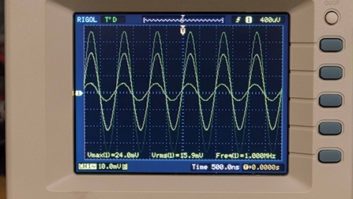Determine AM Modulation with an Oscilloscope
Feb 2, 2003 12:00 PM
The table below allows you to easily determine the modulation level of an AM transmitter. Connect an RF sample to the horizontal input of an oscilloscope and set the peak-to-peak (pk-pk) unmodulated carrier level to occupy two divisions. Then apply modulation and read the peak-to-peak level. Find the nearest number in the scope division column below and read the modulation percentage from the left-most column of the same row.
�Modulation (%) Sideband Power (dbc)1Scope Divisions 0 N/A 2.0 �1 -46 2.02 �2 -40 2.04 �10 -26 2.2 �20 -20 2.4 �30 -16.5� 2.6 �40 -14 2.8 �50 -12� 3.0 �60 -10.4� 3.2 �70 -9.1 3.4 �80 -7.9 3.6 �90 -6.9� 3.8 �95 -6.5 3.9 �100 -6.0 4.0 �105 -5.6 4.1 �110 -5.2 4.2 �115 -4.8 4.3 �120 -4.4 4.4 �130 -3.7 4.6 �140 -3.1� 4.8 �150 -2.5� 5.0 �160 -1.9� 5.2 �170 -1.4� 5.4 �180 -0.9 5.6 �190 -0.4� 5.8 �200 0.0 6.0
�1 – The power in each sideband relative to the carrier power (dBc), is determined by
Pssb = 10log(Pssb/Pc), where Pssb is the power in a single sideband, and Pc is the carrier power.
The power in a single sideband is equal to one-half the modulation power. Modulation power is determined by
Pm = m2(Pc)/2, where Pm is the modulation power, m is the modulation index (percentage expressed as a decimal), and Pc is the carrier power.
Source: The AM Window






